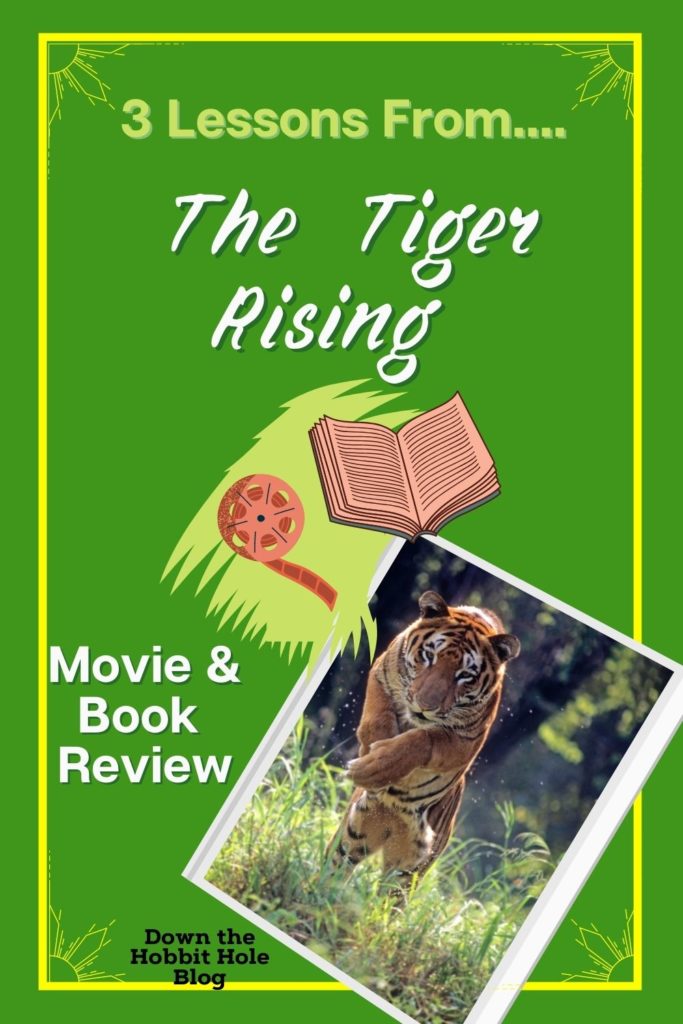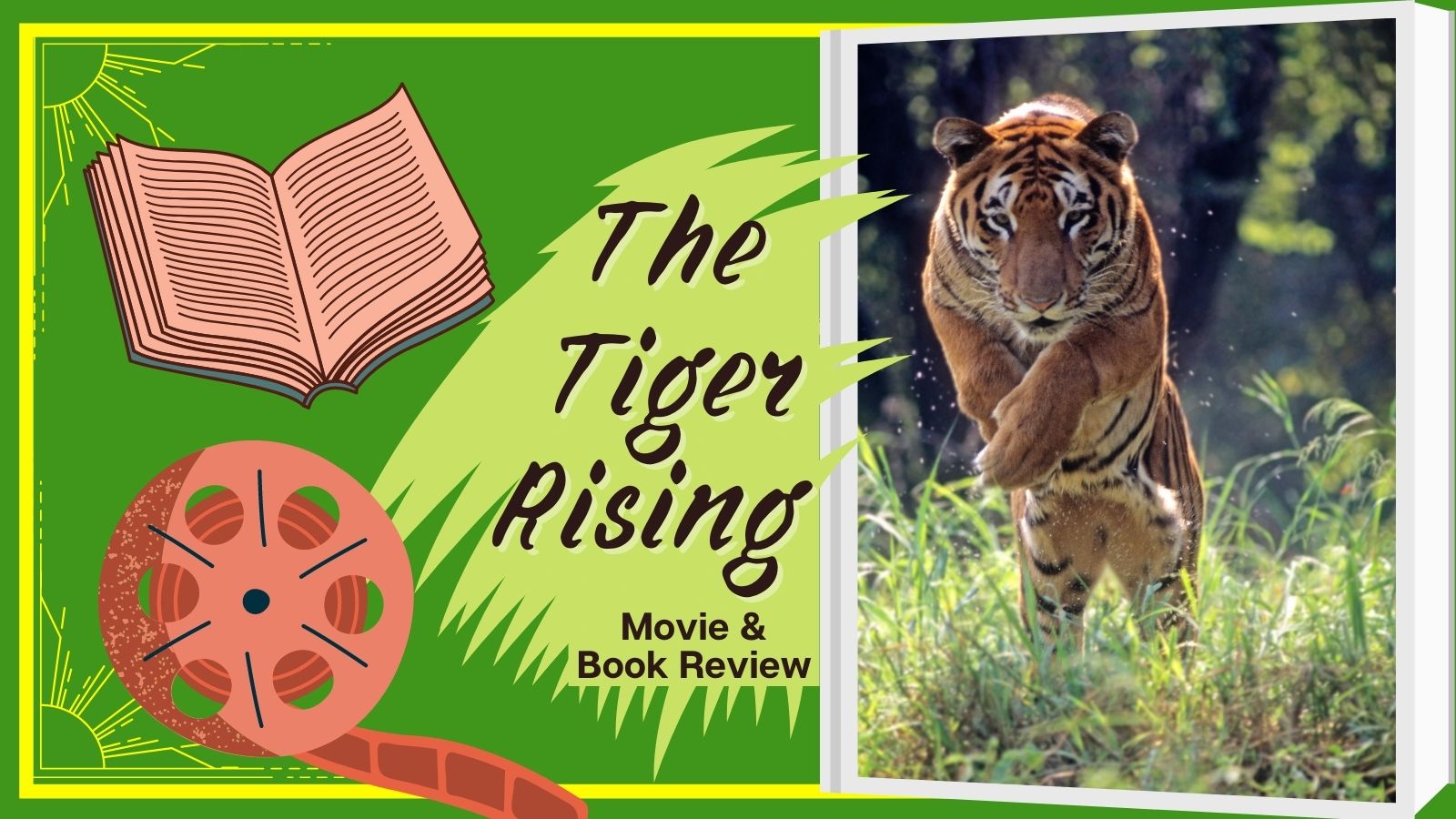Lessons from Tiger Rising written by the Ent. This post contains affiliate links, you can find out more on our policies page or in the disclaimer at the bottom of the blog.
Know Before You Watch
Movie: Tiger Rising
Rating: PG
Genre: Childrens, Drama
Length: 1 hr. 42 mins
Age suggested: 7 and up
Release Date: January 21st, 2022
Warnings: Death of a Parent, Being Left by Parent, Bullying, mild violence/abuse
Quick The Tiger Rising Summary
Rob is a kid who livesin Florida. He lives in a motel with his recently widowed father and is forced to stay home from school until his leg rashes cease. During his prior day of school, two big events happened to Rob. Firstly, he meets the new girl named Sistine. Secondly, he finds a tiger locked in a cage in the land behind the motel. Rob must learn to handle his new friendship while also coming to terms with his grief and sorrow.
The Tiger Rising Movie Review (Contains Spoilers)
-Is The Tiger Rising Appropriate?-
The main plot of the The Tiger Rising involves Rob dealing with his emotions, specifically with the recent loss of his mother. With that in mind, there is a lot of thoughts about grief and sorrow. This is also seen from Sistine, whose father has recently abandoned her family. These topics in an of themselves are not to be a point of concern for most younger viewers as it could lead to good discussion. But if a young viewer is either too young to deal with these thoughts or has recently gone through similar events, this movie may hit too close.
The other things to consider in this movie is the consistent bullying, which really does not get resolved and the mild violence found at the school. Rob is consistently bullied throughout the story, but doesn’t stand up for himself. On the other hand, Sistine actively involves herself in fighting, sometimes starting it herself. Also, in the book, there is a statement that the dad “slapped rob to make him stop crying”, but this does not take place in the movie. Lastly, the tiger is shot and killed at the end of the film, which may be troubling to younger viewers
Continue reading for our lessons from Tiger Rising and Discussion Questions
–Why Watch Tiger Rising-
The Tiger Rising provides a powerful dive into the world of grief. This is done in a surprisingly light-hearted, but nevertheless still very poignant way. This is a great movie to discuss metaphors (the tiger) and how things can have more than one meaning. The plot could be a bit slow for younger viewers, but the kids’ personalities really do carry the film frequently. There is also some beautiful artwork as Rob sees thing imaginatively. Overall, The Tiger Rising is a great, powerful movie that is a great way to show younger viewers that movies can have deeper meanings.
Quotes from the Movie
He made all his feelings go inside the suitcase; he stuffed them in tight and then sat on the suitcase and locked it shut.
Ain’t nobody gonna rescue you. You got to rescue yourself
The Tiger Rising Movie vs the Book
5 Similarities and Differences
1. Overall Plot
The Tiger Rising movie does a great job at taking the plot that DiCamillo laid out and painting it onto the big screen. From the big, overarching story of Rob and Sistine to the small details of the principal and whittling, it all shines bright. There are small tweaks that were made here and there, but overall the story as a whole stays intact.
2. Mrs. Mills (Art Teacher)
The movie contains an additional character named Mrs. Mills. She is the art teacher at Rob’s school who takes a special interest in Rob’s artistic abilities. Although she doesn’t play a huge role in the plot, she does highlight Rob’s abilities, which especially shines through his sculptures created through whittling.
3. “No Crying” Subplot
Throughout the movie and the book, Rob is dealing with this notion that he is not allowed to cry. Both involve the fact that his father told him to stop. However, in the book, it is stated that Rob’s father “slapped rob to make him stop crying.” This does not occur in movie. Rather, it is simply just a stated fact that they both aren’t supposed to cry.
4. Flashbacks to Time with Mom
Rob’s deceased mother does play an important role in both the book and the movie, but the movie has several scenes that are specifically dedicated to showing the role the mother had in Rob’s artistic ability. This is somewhat implied in the book, but does not have these interntional scenes of attachment.
5. The Tiger
Obviously, the tiger is going to appear in both the movie and the book. But what isn’t so obvious is that the same meaning and metaphors of the tiger remain in both. The tiger represents different things for the different characters, but even this stay consistent through both forms of media. The only big difference is at the very end when Rob’s father shoots the tiger. In the book, this is solely in order to protect the children and other people in general. In the movie, however, there is a pretty heavy implication that Rob’s father may have been wanting to shoot Mr. Beauchamp.
Continue reading for our lessons from Tiger Rising and Discussion Questions
Conclusion on The Tiger Rising Movie vs Book
Overall, The Tiger Rising movie is a fantastic adaption of Kate DiCamillo’s 2001 book. There were minor changes made to either enhance the story or to remove things that may have been a bit more controversial. The same power and lessons from Tiger Rising shine through the big screen, which in my opinion was the most important aspect of this adaptation.
The Tiger Rising Discussion Questions
Themes to Discuss: Handling emotions/emotional suppression, Dealing with grief, Being bullied
- What does the caged tiger represent for Rob and Sistine? Why do they see it so differently?
- Which character did you enjoy the most? What did you like about them?
- If you could whittle anything, what would you whittle?
- What are some healthy and unhealthy ways people manage their emotions? When you are angry or upset, how do you manage your emotions?
- Why does Rob have the rash on his legs? What eventually causes them to disappear?
- How does Sistine help Rob throughout the story? How does Rob help Sistine?
3 Lessons from Tiger Rising
1. The Importance of Dealing with Emotions
This is the main focus of the plot of The Tiger Rising. Both Rob and Sistine are struggling with emotions. Rob is still processing with the grief of losing his mother and Sistine is processing the anger after her father leaves them. The whole movie, especially the tiger, deals directly with how each character process their emotions differently. Rob and his father are both trying to bottle in their emotions while Sistine is going through her emotions by lashing out. By the end of the story, everyone learns the importance of confronting and dealing with their emotions, even if it is hard.

2. We Need Friends to Grow
There is an argument to be made that if Sistine never entered Rob’s life, his life would have gone down a darker road. Willie was there for Rob’s support, but he needed a peer who he could really talk to. On top of that, she was a powerhouse and refused to let him clam up as he wanted to. This may not always be the best way, but this pairing worked really well. Rob was also able to calm the anger of Sistine when she needed him.
3. Building Up Our Emotions Has Consequences
In the climax of the movie, the tiger that has represented containing and limiting emotions is finally set free. Soon after leaving his cage, the tiger is shot and killed. Although this feels like a mixed message, the lesson here is a bit harrowing. It shows the importance of releasing emotions in a healthy way. When built up for too long, they may become dangerous.
Know Before You Read
Book: The Tiger Rising
Author: Kate DiCamillo
Genre: Childrens, Drama
Pages: 121
Published: March 2001
Age Suggestion: 8 and up
Warnings: Death of a Parent, Being Left by Parent, Bullying, mild violence/abuse
The Tiger Rising Book Parent Review
Ultimately, The Tiger Rising Book and Movie are very similar. The book however may be more digestable for some readers. Each chapter is broken up into short chapters (about 4 pages per chapter). The same themes and topics are discussed and Kate Dicamillo does an amazing job really getting you into the head and emotions of Rob. The book is filled with wonderful metaphors and imagery that could be very important to discuss with kids. The story, characters, and setting all come together perfectly in order to show the true power of emotions and how to healthily (and unhealthily) deal with them.
Why Read The Tiger Rising Book
Despite the fact that The Tiger Rising movie is a genuinely very good adaptation of the book, we would still highly recommend reading the book. One thing that very few movies are able to capture is the internal dialogue of its characters. This is very true of Rob. It is so powerful to see Rob grow and struggle through his own thoughts and grief, but it also makes for a very powerful story. Ultimately, our suggestion is simply pick whichever media is best for you or your family (or even both).
Thanks for reading our Lessons from Tiger Rising. Before you go, check out these other posts:
–Flora and Ulysses Movie vs Book also from Kate Dicamillo
–The Beatryce Prophecy Review- a New Book from Kate Dicamillo
–Timmy Failure: Mistakes Were Made review!
-Our One and Only Ivan Full Parent Review and our Curriculum for it
Down The Hobbit Hole Blog and Lessons from Tiger Rising use affiliate links. We only link products we think you’ll like and you are never charged extra for them. As Amazon Associates, we earn from qualifying purchases at no additional cost to you. We also use cookies to gather analytics and present advertisements. This allows us to keep writing discussion questions and telling ridiculous dad jokes. Find our other reviews with discussion questions here. Our posts about faith here. And our posts about family stuff here.
